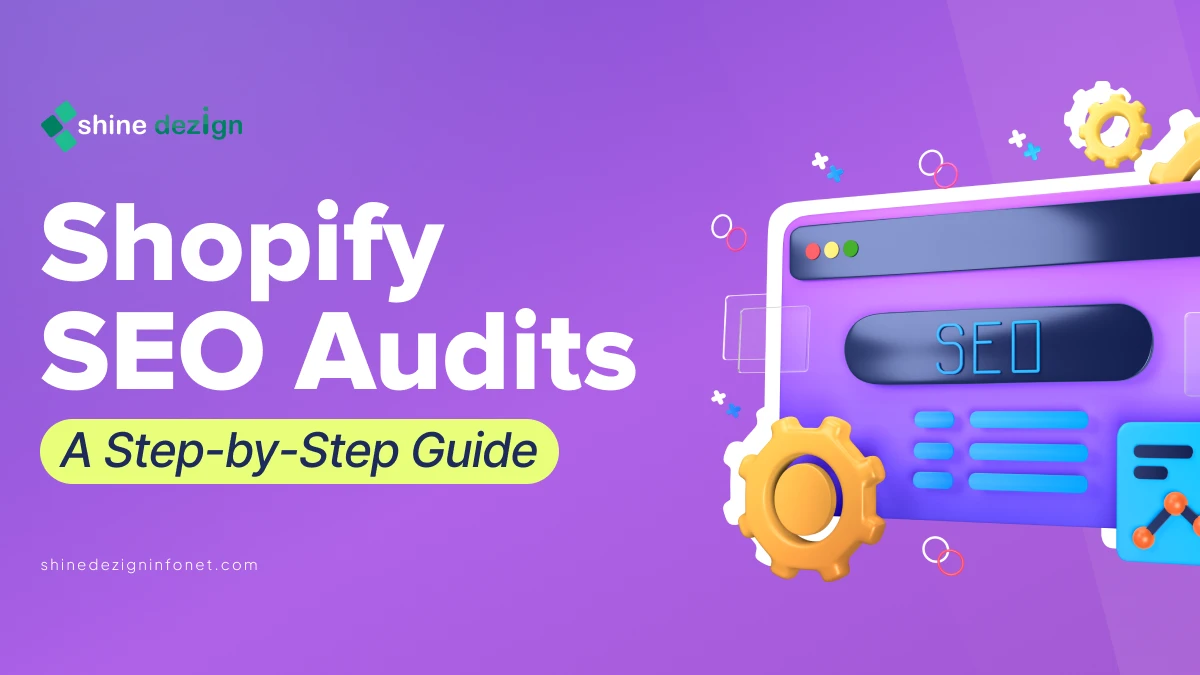Table of Contents
Having a stunning and meticulously crafted Shopify store is just the first step. To truly succeed, your store needs to be discoverable. This is where Shopify’s Search Engine Optimization (SEO) performance comes into play.
In this comprehensive guide, we will walk you through the crucial process of conducting a Shopify SEO audit. But first, let’s understand why a Shopify SEO audit is important for your online store.
Why is SEO Audit important for your Shopify Store?
An SEO (Search Engine Optimization) audit plays a pivotal role in enhancing the performance of your Shopify store. Firstly, it serves as a catalyst for improved search engine rankings, involving critical elements like content quality, meta tags, and site structure.
By optimizing these factors, your store becomes more likely to appear prominently in search engine results pages (SERPs). An audit plays a pivotal role in enhancing the performance of your Shopify store.
Firstly, it catalyzes improved search engine rankings, delving into critical elements like content quality, meta tags, and site structure. Also, by optimizing these factors, your store becomes more likely to appear prominently in search engine result pages (SERPs), thereby increasing visibility and potential traffic.
Let’s explore more in the Step-by-Step Guide of SEO Audit
Types of Audits
-
- On-Page SEO Audit
- Technical SEO Audit
- Content Audit
- Backlink Audit
- Local SEO Audit
1. On-Page SEO Audit
On-page optimization is the cornerstone of an effective Shopify SEO strategy. This audit focuses on elements that are directly visible on your Shopify store’s pages, ensuring they are finely tuned for both search engines and a positive user experience.
On-Page Elements
Start by evaluating and optimizing critical on-page elements like meta-titles, meta-descriptions, header tags, and image alt text. Crafting compelling and keyword-rich content for these elements enhances your store’s visibility in search results.
Also, optimizing header tags can organize content hierarchically, with H1 being the main heading and subsequent tags (H2, H3, etc.) representing subheadings.
2. Technical SEO Audit
The technical aspects of your website play a pivotal role in search engine rankings. Break down your technical audit into the following factors:
Site Structure
Ensure a clear and logical site structure, making navigation easy for both users and search engine crawlers. A well-organized not only improves user experience but also helps search engine understand not only improves user experience but also helps search engine understand the hierarchy of your content.
Opt for apps developed by reputable companies with a track record of providing secure solutions.
Mobile Optimization
Given the increasing number of users accessing websites via mobile devices, optimizing mobile responsiveness is paramount. Google considers mobile-friendliness as a ranking factor, making it crucial for SEO success.
Page Speed Insights
Improve page loading times to enhance the user experience and meet search engine criteria for faster websites. Slow-loading pages can lead to a high bounce rate, negatively impacting your SEO performance.
Core Web Vitals
Also, core web vitals are a subset of web vitals applicable to all web pages. They are essential metrics for all site owners, integrated into various Google tools. These metrics are:
LCP (Largest Contentful Paint): This metric measures loading performance. To provide a good user experience, LCP should occur within 2.5 seconds of when the page first starts loading.
FID (First Input Delay): This measures interactivity. To provide a good user experience, pages should have an FID of 100 milliseconds or less.
CLS (Cumulative Layout Shift): This measures visual stability. To provide a good user experience, pages should maintain a CLS of 0.1. or less.
INP (Interaction to Next Paint): This metric evaluates a page’s responsiveness to user interactions by measuring the time it takes for the page to respond to clicks, taps, and keyboard inputs throughout a user’s visit.
HTTPS and Security
Secure your Shopify store with HTTPS to encrypt data transfer between the user’s browser and your server. This not only instills trust in visitors but also earns a ranking boost from search engines, as they prioritize secure websites.
3. Content Audit
Content is the heart of SEO. Evaluate and enhance your content strategy with a focus on:
Product Descriptions
Craft unique, persuasive, and keyword-optimized product descriptions for better search visibility. Provide detailed information about your products, addressing potential customer queries and concerns.
Blog Content
Develop informative and engaging blog content that not only caters to your audience but also aligns with search engine algorithms. Regularly publishing relevant content establishes your store as an authority in your niche.
User-Generated Content
Leverage user reviews and testimonials to build credibility and enhance SEO. User-generated content not only provides valuable insights for potential customers but also serves as a signal to search engines about your store’s authenticity.
4. Website Backlink Audit
Identifying Backlinks
These tools meticulously crawl the web, unveiling the intricate network of links leading to your Shopify store Audit. This process unveils not just the quantity but also the quality of backlinks, providing a nuanced understanding of your digital footprint.
Quality Over Quantity
Quality backlinks are those originating from websites with established authority, relevant content, and a solid reputation. These links act as trust signals to search engines, contributing positively to your store’s perceived credibility.
Competitor’s Backlink Analysis
Analyze the backlinks of competitors to discover potential linking opportunities. Identify common backlink sources within your industry Shopify SEO analysis goes beyond mere emulation; it’s about strategic observation. Identify the authoritative domains linking to your competitor and determine whether similar links could benefit your store.
5. Local SEO Audit (if applicable)
Google My Business (GMB) Optimization
Claim and verify your Google My Business listing. Ensure that your business information, such as name, address, phone number (NAP), and business hours, is accurate and consistent.
Local Citations
Build local citations on online directories and platforms. Consistent NAP information across the web establishes trust and helps with local search rankings.
Localized Content
Create content that is relevant to your local audience. This can include localized keywords, customer testimonials from local clients, and information about local events or partnerships.
Shopify-Specific SEO Settings (if applicable)
URL structures
Customize and optimize your Shopify store’s URL structure. Use clean, descriptive URLs that include relevant keywords. Avoid using default or generic URL structures.
301 Redirects
Implement 301 redirects for any changed URLs or when migrating from an old website. This ensures that link equity is transferred and users are seamlessly redirected to the correct pages.
Canonical Tags
Use canonical tags to indicate the preference of a page when there are multiple URLs with similar content. This helps prevent duplicate content issues and consolidates ranking signals.
Analytics and Monitoring
Implement robust analytics tools to monitor your store’s performance. Regularly review key metrics, such as traffic conversion rates and keyword rankings. Analytics provide valuable insights into the effectiveness of your SEO strategy, helping you identify areas for refinement and improvement.
By systematically conducting these audits, you will not only boost your Shopify store’s visibility but also enhance the user experience, ultimately driving more organic traffic and conversions. Stay proactive in updating your SEO strategy as search engine algorithms evolve, ensuring sustained success in the competitive eCommerce landscape. Remember, SEO is an ongoing process, and regular audits are essential to staying ahead in the ever-changing digital environment.
Summing Up
By incorporating these strategies into your SEO efforts, you can enhance the overall visibility and performance of your Shopify store in search engine results. Regularly monitor and update these elements to adapt to changes in search engine algorithms and maintain a competitive edge.



















